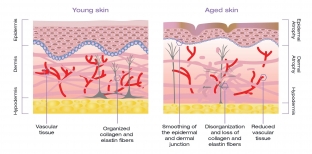Cosmetologists note that patients most often turn to them with a request to choose minimally invasive and maximally harmless procedures to eliminate signs of skin aging – the so-called "age syndrome". Women complain of the appearance of wrinkles (static and dynamic), deterioration of complexion, the appearance of a vascular pattern, a decrease in skin elasticity and dryness, deformation of the face oval, tissue ptosis, the appearance of dark circles and bags under the eyes. The severity of such changes depends not so much on the age of the patient, but on the genetic predisposition, lifestyle and the intensity of the influence of external factors that contribute to premature aging. An important step in the aesthetic correction of the face is to improve the quality of the skin and start the natural rejuvenation process.
Age syndrome: what happens in different layers of the face?It is well known that the aging process affects not only the skin, but also the deeper layers of the face:
- muscles (hypertonicity, fibrosis, increased adipose tissue content);
- adipose tissue (resorption, ptosis, atrophy or hypertrophy, depending on the zone);
- ligamentous apparatus (relaxation of the lateral canthal ligament, loosening of the temporomandibular joint);
- bone tissue (decreased height of the jaws, changes in the cartilages of the nose, flattening of the zygomatic arch and thinning of the edge of the orbit).
The degree of severity of signs of aging largely depends on the condition of the patient's skin (its firmness, elasticity, thickness, hydration).As for the quality of the skin, it also decreases with age due to natural aging mechanisms and external influences, affecting the severity of the signs of aging. That's why it's important to know:
- what changes occur at the level of the epidermis and dermis;
- how to improve the quality of the skin with age syndrome.
Skin aging occurs mainly in its two layers – dermis and epidermis:
- Slowdown of cell regeneration leads to thickening of the superficial (horny) layer of the epidermis, resulting in dryness and roughness of the skin. At the same time, the epidermal layer itself becomes thinner.
- Gradual destruction of existing collagen and elastin fibers, their chaotic arrangement, reduced synthesis of new fibers of "youth proteins"; due to a decrease in the functional activity of fibroblasts, a decrease in synthesis and an accelerated loss of hyaluronic acid – the main reasons for the loss of the ability to retain moisture, as well as a decrease in elasticity and firmness of the skin. Also, every 10 years, the dermis thins by about 6%.

The dermal-epidermal junction gradually becomes thinner and weaker, resulting in deterioration of the skin's metabolism.Fibroblasts, which are responsible for the synthesis of the most important substances of the extracellular matrix necessary for youthful skin, are also subject to age-related degeneration (flatten, become rigid, increase in size). The violation of their function is also facilitated by:
- lack of oxygen in the skin;
- accumulation of protein metabolites;
- AGEs (glycation end products);
- ultraviolet radiation, etc.
This is why Medicare Non-Invasive Carboxytherapy is successfully used not only as a monotherapy, but also in combination with other rejuvenation methods.
Carboxytherapy for age-related syndrome – the key to improving skin quality
German
Medicare Carboxytherapy solves the problem of lack of oxygen in the skin due to the action of molecular carbon dioxide (CO2), which easily penetrates the skin and contributes to:
- saturation of cells with oxygen;
- increased blood fluidity;
- pH normalization;
- dilation of blood vessels;
- fibroblast stimulation;
- excretion of protein metabolites;
- stimulation of skin regeneration;
- restoring the protective functions of the skin.
Carboxytherapy in the fight against age-related syndrome can be used both as monotherapy and in combination with invasive techniques.Research has shown that Medicare Carboxytherapy can help tighten skin by up to 46% and strengthen the dermal-epidermal junction. Thanks to the restoration of normal metabolism and the launch of a natural rejuvenation process, fine wrinkles are smoothed by 56%, and also:
- improves skin color and texture;
- the clarity of the oval of the face increases;
- skin tightens;
- the severity of acne and post-acne decreases;
- improves lymphatic drainage.
Some patients who have significant tissue ptosis, loss of volume, deep wrinkles, will need to resort to To get detailed protocols for non-invasive carboxytherapy, purchase the necessary drugs for procedures, receive training and get answers to all your questions, contact
Medicare today!







Add a comment